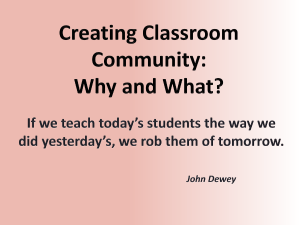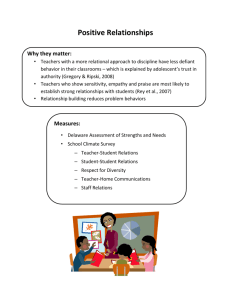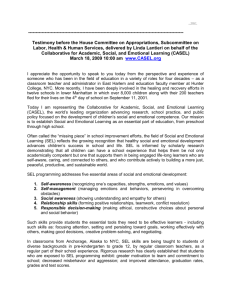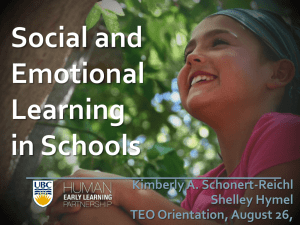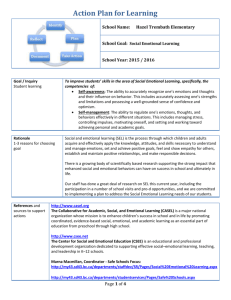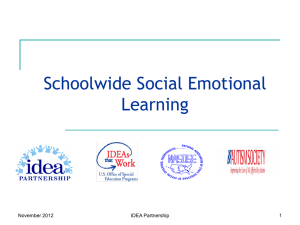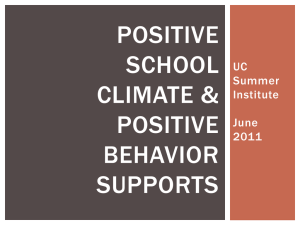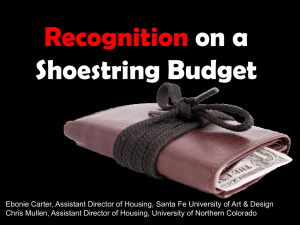School-wide PBS is - Brooke Elementary
advertisement
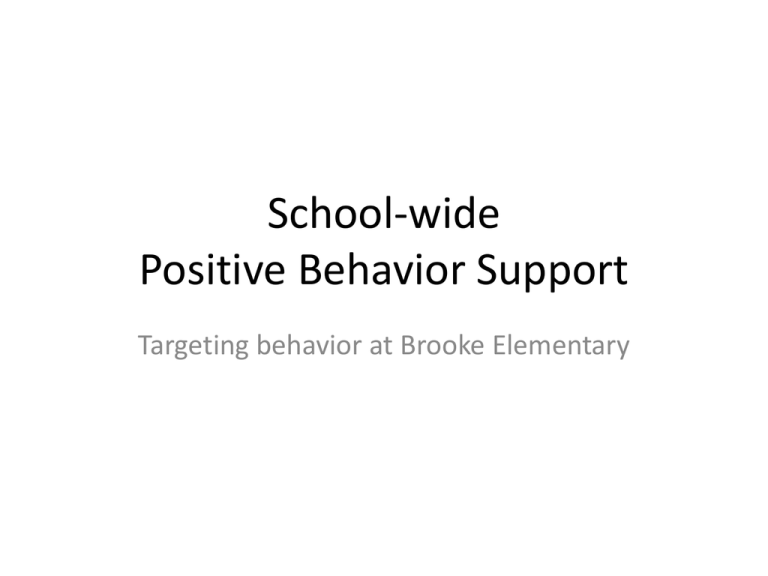
School-wide Positive Behavior Support Targeting behavior at Brooke Elementary Norms Practice Active Listening Participate Use Technology Appropriately Step Up and Step Back Be Respectful of Time Goals for today • Define the logic and core features of Schoolwide PBS • Define the implementation approach • Define core features of classroom management Logic for School-wide PBS • Schools face a set of difficult challenges today • Multiple expectations (Academic accomplishment, Social competence, Safety) • Students arrive at school with widely differing understandings of what is socially acceptable. • Individual student interventions • Effective, but can’t meet the need as a school. • School-wide discipline systems • Establish a social culture within which both social and academic success is more likely The Challenge • Lack of discipline is viewed as one of the most serious challenges facing public schools – National Education Goals Report • Teachers report that “uncivil” behavior is increasing and is a threat to effective learning – Skiba and Peterson, (2000) • There is a link between general level of disruptive behavior and more extreme acts of violence – Skiba and Peterson, (2000) Research Findings • The same research reviews indicate that the most effective responses to school violence are: – Social Skills Training – Academic Restructuring – Behavioral Interventions – Family supports and follow through » » » » Gottfredson, 1997 Elliot, Hamburg, & Williams, 1998 Tolan & Guerra, 1994 Lipsey, 1991; 1992 What is School-wide Positive Behavior Support? • School-wide PBS is: • A systems approach for establishing the social culture and individualized behavioral supports needed for schools to be effective learning environments for all students. • Evidence-based features of PBS • • • • • • • Prevention Define and teach positive social expectations Acknowledge positive behavior Arrange consistent consequences for problem behavior On-going collection and use of data for decision-making Continuum of intensive, individual interventions. Administrative leadership – Team-based implementation (Systems that support effective practices) School-wide Systems (All students all settings all times) Create a positive school culture: School environment is predictable 1. common language 2. common vision (understanding of expectations) 3. common experience (everyone knows) School environment is positive regular recognition for positive behavior School environment is safe violent and disruptive behavior is not tolerated School environment is consistent adults use similar expectations. PBS Subsystems Classroom Family Non-classroom Student Activity: 1 Pop Quiz What does Brooke have in place to target our students’ behavior? What has your child communicated to you? 2 minutes (write it on a post it) Answers Prevention: 1) Mentoring programs 2) SEL curriculum-Teacher social skills lessons. 3) Positive praise 4) Role model gift certificates 5) Classroom social Contracts Positive rewards: 1) Lion’s pride 2) Brooke-Mart 3) Grade level activities and prizes 4) Field Trips Intense behavior interventions 1) 2) 3) Individual behavior contracts with target behavior goals. Reach out to parents. Recommendation for outside supports (counseling, doctor evaluations, social worker, after school clubs) 4) Daily student and staff conversations 5)Office/lunch reflection time 6) Written reflection papers/social contracts 7) In-school suspension *********************************************************** 8) LAST resort: Home Suspension *This is a last resort and one that we don’t like to use. ( We need your support to help prevent this) Social Contracts Students always have choices to correct behaviors: JJAEP DAEP Home suspension ISS Detention Office Referral Time – out another room Time – out in the back of the room Time – out at your desk Peace chair-calm down spot Planned ignoring Teacher correction Teacher redirection (verbal) Teacher redirection (non – verbal) Ignoring Token economy Praise effort Verbal praise Non verbal praise Intermittent praise Engagement / encouragement Acknowledgement Skill development Motivation Connection Activity 2: Table Talk As a family what can you do to help our students achieve success academically and with behavior? Research recommendations • Establish “intolerant attitude toward deviance” – Break up antisocial networks…change social context – Improve parent effectiveness with academics • Increase “commitment to school” – Increase academic success – Create positive school climates • Teach & encourage individual skills & competence Brooke Discipline Data 2014-2015 Grade Level Office referrals Type of referral Pre-K 5 Physical Aggression, Destruction Kinder 12 Physical Aggression, Disruption 1st 4 Disruption 2nd 13 Physical Aggression, disruption 3rd 8 Rude to student, disruption 4th 19 Insubordination, physical aggression 5th 65 Insubordination, Physical aggression, disruption, theft Part II: SEL Social Emotional Learning The Five Competencies CASEL has identified five core areas of social and emotional competence. Self-Awareness Responsible Decision Making Relationship Skills SelfManagement Social Awareness © CASEL 2012 19 Las Cinco Competencias CASEL ha identificado cinco areas comunes de la competencia social e emocional Conocimiento de si mismo Toma de decisiones responsables Mantener buenas relaciones © CASEL 2012 Auto-Control Conciencia Social 20 Conflict is Normal at Every Stage Ages 6 – 9: • Serial Best Friends • Navigating competition • Recognizing that others have different opinions • Success can lead to feelings of competence; and failure leads to feelings of inferiority Ages 10 – 14: • Thinking more like adults but without life experiences • Accepting by peers and fitting in • Friendship and romantic feelings blend • Group identity can lead to cliques Ages 15 – 18: • Increasing independence and necessity for rules • Internal issues may lead to mental health issues • Dating • Emphasis on friends and time away from home s Controlar Sentimientos • • • • • Sentimos emociones Controlar frustración Calmar sentimientos fuertes Controlar enojo Controlar acusaciones, desilusión, ansiedad o sentimientos heridos • Enfrentar humillaciones • Controlar ansiedad por exámenes • Resistir el deseo de tomar venganza y evitar sacar conclusiones precipitadas What do you do to calm down? Que hacen uds. para calmarse? What are some strategies for self-regulation? Que son algunas estrategias para auto-regularizarse? Peace Paths Middle School Posters AISD SEL Resources External SEL Resources AISD SEL: austinisd.org/academics/sel CASEL: casel.org/ Blog: aisdsel.wordpress.com/ Second Step: cfchildren.org/ FB: facebook.com/AustinISDSEL School Connect: school-connect.net/ Twitter: twitter.com/AustinISDSEL Kagan: kaganonline.com/ Pinterest: pinterest.com/austinisdsel/ Conscious Discipline: consciousdiscipline.com/ Child Study Team: childstudysystem.com/ Capturing Kids Hearts: flippengroup.com/education/ckh PART III • Middle school success • Building good study habits • Recognizing behavior patterns • Addressing behavior • Setting up academic time Discussion Time What does your child’s work space look like? Create a Study Zone How should it look? • • • • • • Comfortable No Distractions Well lit Organized Necessary supplies Personalize it Students remember more if they do their homework in the same place and same time each night! Setting Study Zone Routines When student gets home they should empty Home/School Communication Folder and organize papers in their Study Zone Student adds new information to monthly calendar Parent checks Study Zone Student puts signed papers back in Home/School Communication Folder Student and parent create a To-Do list Handling Homework 1. Ask questions about assignments 2. Discuss your involvement and role in tonight's study session 3. Student crosses out or checks off each assignment as it is completed 4. As SOON as each assignment is completed and parent checks it, the student should put papers immediately in their Home/School Communication Folder 5. Rewards student’s progress! Activity question: How will you act when schools communicate with you about possible behavior patterns? Recommendations: Be proactive Find the root of the problem Communicate with teachers frequently Talk with your child daily Monitor their activity online and offline Ask questions!
